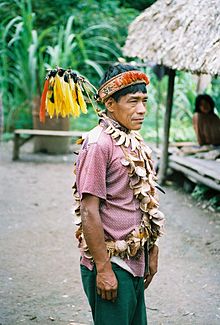
The Urarina are an indigenous people of the Peruvian Amazon Basin (Loreto) who inhabit the valleys of the Chambira, Urituyacu, and Corrientes Rivers.[1] According to both archaeological and historical sources, they have resided in the Chambira Basin of contemporary northeastern Peru for centuries.[2] The Urarina refer to themselves as Kachá (lit. "person"), while ethnologists know them by the ethnonym Urarina.
The local vernacular term for the Urarina is Shimaku,[3] which is considered by the Urarina to be pejorative, as it is a Quechua term meaning "unreliable".[4] The ethnonym "Urarina" may be from Quechua--uray meaning below, and rina referring to runa, or people. Urarina is rendered in Quechua as uray-runa or people from below or down stream people.[5]
- ^ Dean, Bartholomew 2009 Urarina Society, Cosmology, and History in Peruvian Amazonia, Gainesville: University Press of Florida ISBN 978-0-8130-3378-5 [1]
- ^ (in Spanish) Myers, Thomas P. and Bartholomew Dean “Cerámica prehispánica del río Chambira, Loreto.” Amazonía peruana, 1999 Lima, Published by the Centro Amazónico de Antropología y Aplicacíon Práctica. 13(26):255-288
- ^ (in Spanish) Spanish wiki entry for Shimaku
- ^ Payne, Thomas E. (1997). Describing morphosyntax: A guide for field linguists. Cambridge: Cambridge University Press. p. 13. ISBN 9780521588058.
- ^ For more information, see Paz Soldan 1877:964; Espinoza Galarza 1979:305). Native inhabitants of the Chambira Basin have also been called various names, including: Itukales; Ytucalis, Singacuchuscas; Cingacuchuscas; Aracuies; Aracuyes; Chimacus; and Chambiras (Grohs 1974:53 fn. 4; Velasco 1960: 267; Jouanen 1943, II: 471-2; Figueroa 1904: 163, 177)